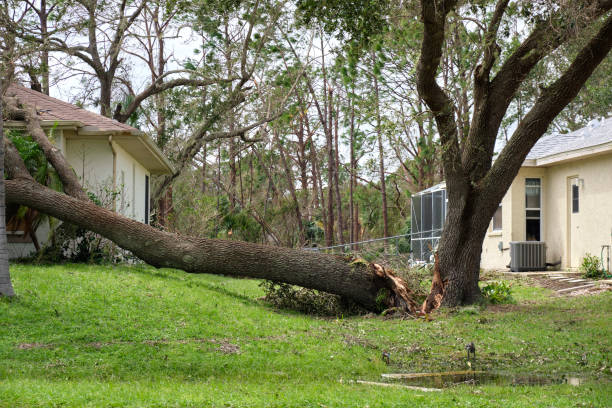Trees are a vital part of our environment, providing shade, beauty, and even improving air quality. However, there are situations where a tree can become a hazard, requiring immediate removal. Emergency tree removal is a critical service that addresses dangerous situations involving trees, ensuring the safety of people, property, and surrounding structures. In this article, we’ll explore the reasons for emergency tree removal, the signs that indicate a tree is hazardous, and the steps involved in the removal process.
What is Emergency Tree Removal?
Emergency tree removal is the process of quickly and safely removing a tree that poses an immediate threat. This could be due to storm damage, disease, structural instability, or other factors that make the tree likely to fall or cause harm. Unlike routine tree removal, which can be scheduled in advance, emergency tree removal requires urgent action to prevent accidents, injuries, or property damage.
Common Reasons for Emergency Tree Removal
- Storm Damage
Severe weather, such as hurricanes, thunderstorms, or heavy snowfall, can cause trees to break, split, or uproot. A partially fallen tree or hanging branches can be extremely dangerous and require immediate attention. - Disease or Decay
Trees affected by disease or decay can become weak and unstable. If a tree shows signs of extensive rot or fungal growth, it may be at risk of collapsing unexpectedly. - Leaning Trees
A tree that suddenly starts leaning to one side may indicate root damage or soil instability. This can be a sign that the tree is about to fall, especially during high winds or heavy rain. - Dead or Dying Trees
Dead trees are brittle and can drop branches or fall entirely without warning. If a dead tree is located near a home, driveway, or pedestrian area, it should be removed as soon as possible. - Proximity to Structures or Power Lines
Trees growing too close to buildings, power lines, or other structures can pose a significant risk. In emergencies, such as a tree touching power lines, professional removal is essential to avoid fires or electrical hazards. - Root Damage
Construction work or soil erosion can damage a tree’s root system, compromising its stability. If the roots are no longer able to support the tree, it may need to be removed urgently.
Signs That a Tree Requires Emergency Removal
Not all tree hazards are obvious, but there are several warning signs to watch for:
- Cracks or Splits in the Trunk: Deep cracks or splits can indicate structural weakness.
- Fungal Growth: Mushrooms or fungi growing at the base of the tree may signal internal decay.
- Hollow Trunk: A hollow trunk can make a tree unstable and prone to falling.
- Uprooted Roots: Visible roots that are lifting out of the ground suggest the tree is no longer securely anchored.
- Dead Branches: Large dead branches, especially those hanging precariously, can fall without warning.
If you notice any of these signs, it’s important to contact a professional arborist or tree removal service immediately.
The Emergency Tree Removal Process
Emergency tree removal is a complex and potentially dangerous task that should only be performed by trained professionals. Here’s an overview of the steps involved:
- Assessment
The first step is a thorough assessment of the tree and its surroundings. The arborist will evaluate the tree’s condition, the extent of the damage, and the potential risks to nearby structures or people. - Safety Precautions
Safety is the top priority during emergency tree removal. The area around the tree will be cordoned off to protect bystanders, and the team will use specialized equipment, such as harnesses, ropes, and chainsaws, to safely remove the tree. - Tree Removal
Depending on the situation, the tree may be removed in sections to minimize the risk of it falling uncontrollably. In some cases, a crane may be used to lift heavy branches or sections of the trunk. - Cleanup
Once the tree has been removed, the team will clear away debris, including branches, leaves, and wood chips. If necessary, they may also grind the stump to complete the removal process. - Preventative Measures
After the emergency has been addressed, the arborist may recommend preventative measures, such as inspecting nearby trees for signs of disease or instability, to avoid future hazards.
Why Hire a Professional for Emergency Tree Removal?
Attempting to remove a hazardous tree on your own can be extremely dangerous. Professionals have the training, experience, and equipment needed to handle emergency situations safely and efficiently. They also carry insurance, which protects you from liability in case of accidents or damage during the removal process.
Cost of Emergency Tree Removal
The cost of emergency tree removal can vary depending on factors such as the size of the tree, its location, and the complexity of the job. While emergency services may be more expensive than routine tree removal, the cost is justified by the urgency and risk involved. Many tree removal companies offer 24/7 emergency services to address urgent situations promptly.
Preventing Tree Emergencies
While not all tree emergencies can be prevented, regular tree maintenance can significantly reduce the risk. Here are some tips:
- Schedule annual inspections with a certified arborist.
- Prune dead or weak branches regularly.
- Monitor trees for signs of disease or decay.
- Avoid planting trees too close to structures or power lines.
Conclusion
Emergency tree removal is a vital service that protects lives and property from the dangers posed by hazardous trees. Whether a tree has been damaged by a storm, is showing signs of disease, or is leaning precariously, it’s essential to act quickly and enlist the help of professionals. By staying vigilant and addressing potential risks early, you can help prevent emergencies and ensure the safety of your surroundings. If you suspect a tree on your property is hazardous, don’t wait—contact a tree removal expert immediately.





